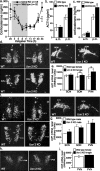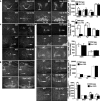Urocortin 2-deficient mice exhibit gender-specific alterations in circadian hypothalamus-pituitary-adrenal axis and depressive-like behavior
- PMID: 16707802
- PMCID: PMC6675306
- DOI: 10.1523/JNEUROSCI.3955-05.2006
Urocortin 2-deficient mice exhibit gender-specific alterations in circadian hypothalamus-pituitary-adrenal axis and depressive-like behavior
Abstract
Gender differences in hypothalamus-pituitary-adrenal (HPA) axis activation and the prevalence of mood disorders are well documented. Urocortin 2, a recently identified member of the corticotropin-releasing factor family, is expressed in discrete neuroendocrine and stress-related nuclei of the rodent CNS. To determine the physiological role of urocortin 2, mice null for urocortin 2 were generated and HPA axis activity, ingestive, and stress-related behaviors and alterations in expression levels of CRF-related ligands and receptors were examined. Here we report that female, but not male, mice lacking urocortin 2 exhibit a significant increase in the basal daily rhythms of ACTH and corticosterone and a significant decrease in fluid intake and depressive-like behavior. The differential phenotype of urocortin 2 deficiency in female and male mice may imply a role for urocortin 2 in these gender differences.
Figures









Similar articles
-
Mice deficient for both corticotropin-releasing factor receptor 1 (CRFR1) and CRFR2 have an impaired stress response and display sexually dichotomous anxiety-like behavior.J Neurosci. 2002 Jan 1;22(1):193-9. doi: 10.1523/JNEUROSCI.22-01-00193.2002. J Neurosci. 2002. PMID: 11756502 Free PMC article.
-
Chronic activation of NPFFR2 stimulates the stress-related depressive behaviors through HPA axis modulation.Psychoneuroendocrinology. 2016 Sep;71:73-85. doi: 10.1016/j.psyneuen.2016.05.014. Epub 2016 May 18. Psychoneuroendocrinology. 2016. PMID: 27243477
-
Abnormal adaptations to stress and impaired cardiovascular function in mice lacking corticotropin-releasing hormone receptor-2.Nat Genet. 2000 Apr;24(4):403-9. doi: 10.1038/74255. Nat Genet. 2000. PMID: 10742107
-
Stress and glucocorticoid receptor transcriptional programming in time and space: Implications for the brain-gut axis.Neurogastroenterol Motil. 2016 Jan;28(1):12-25. doi: 10.1111/nmo.12706. Neurogastroenterol Motil. 2016. PMID: 26690871 Free PMC article. Review.
-
Vasopressin and the regulation of hypothalamic-pituitary-adrenal axis function: implications for the pathophysiology of depression.Life Sci. 1998;62(22):1985-98. doi: 10.1016/s0024-3205(98)00027-7. Life Sci. 1998. PMID: 9627097 Review.
Cited by
-
Musclin prevents depression-like behavior in male mice by activating urocortin 2 signaling in the hypothalamus.Front Endocrinol (Lausanne). 2023 Dec 5;14:1288282. doi: 10.3389/fendo.2023.1288282. eCollection 2023. Front Endocrinol (Lausanne). 2023. PMID: 38116320 Free PMC article.
-
Urocortin 3 modulates social discrimination abilities via corticotropin-releasing hormone receptor type 2.J Neurosci. 2010 Jul 7;30(27):9103-16. doi: 10.1523/JNEUROSCI.1049-10.2010. J Neurosci. 2010. PMID: 20610744 Free PMC article.
-
The CRF Family of Neuropeptides and their Receptors - Mediators of the Central Stress Response.Curr Mol Pharmacol. 2018;11(1):4-31. doi: 10.2174/1874467210666170302104053. Curr Mol Pharmacol. 2018. PMID: 28260504 Free PMC article. Review.
-
Vmat2 heterozygous mutant mice display a depressive-like phenotype.J Neurosci. 2007 Sep 26;27(39):10520-9. doi: 10.1523/JNEUROSCI.4388-06.2007. J Neurosci. 2007. PMID: 17898223 Free PMC article.
-
CRF2 Receptor Deficiency Eliminates the Long-Lasting Vulnerability of Motivational States Induced by Opiate Withdrawal.Neuropsychopharmacology. 2015 Jul;40(8):1990-2000. doi: 10.1038/npp.2015.49. Epub 2015 Feb 12. Neuropsychopharmacology. 2015. PMID: 25672976 Free PMC article.
References
-
- Amat J, Tamblyn JP, Paul ED, Bland ST, Amat P, Foster AC, Watkins LR, Maier SF (2004). Microinjection of urocortin 2 into the dorsal raphe nucleus activates serotonergic neurons and increases extracellular serotonin in the basolateral amygdala. Neuroscience 129:509–519. - PubMed
-
- Arborelius L, Owens MJ, Plotsky PM, Nemeroff CB (1999). The role of corticotropin-releasing factor in depression and anxiety disorders. J Endocrinol 160:1–12. - PubMed
-
- Bale TL, Vale WW (2004). CRF and CRF receptors: role in stress responsivity and other behaviors. Annu Rev Pharmacol Toxicol 44:525–557. - PubMed
-
- Bale TL, Contarino A, Smith GW, Chan R, Gold LH, Sawchenko PE, Koob GF, Vale WW, Lee KF (2000). Mice deficient for corticotropin-releasing hormone receptor-2 display anxiety-like behaviour and are hypersensitive to stress. Nat Genet 24:410–414. - PubMed
Publication types
MeSH terms
Substances
Grants and funding
LinkOut - more resources
Full Text Sources
Other Literature Sources
Molecular Biology Databases
